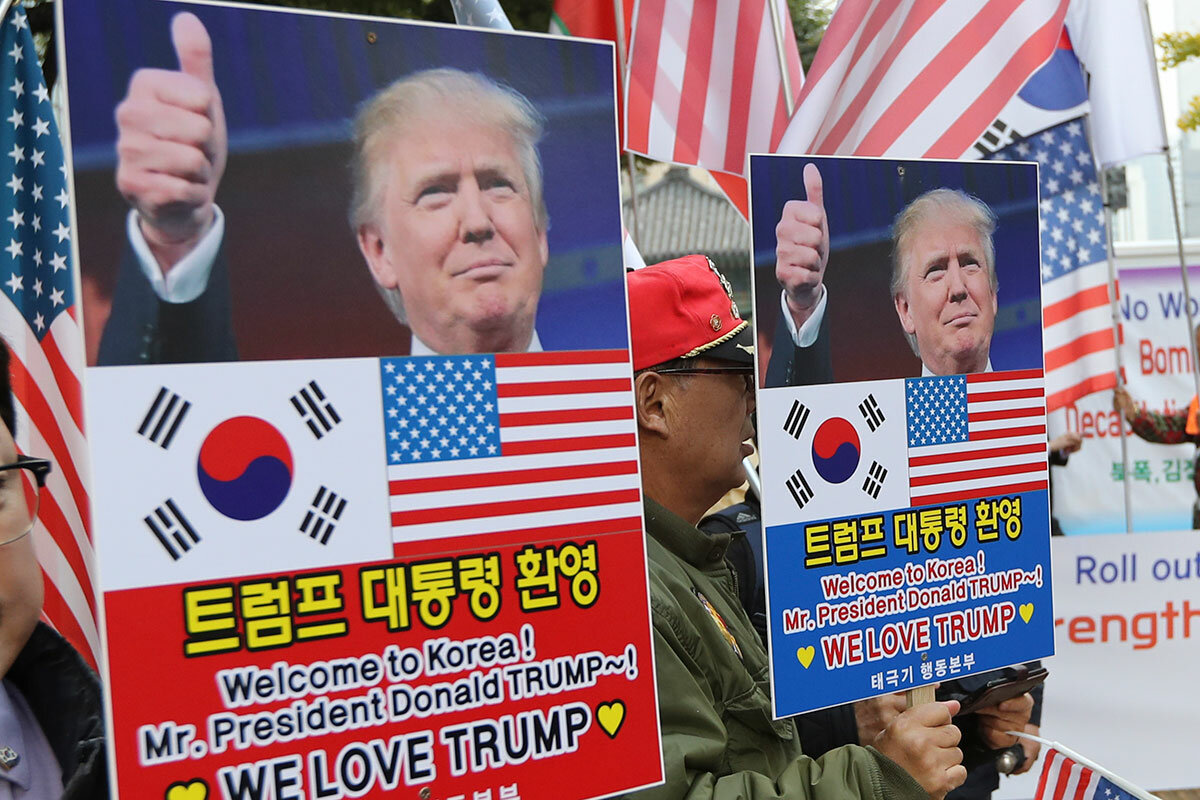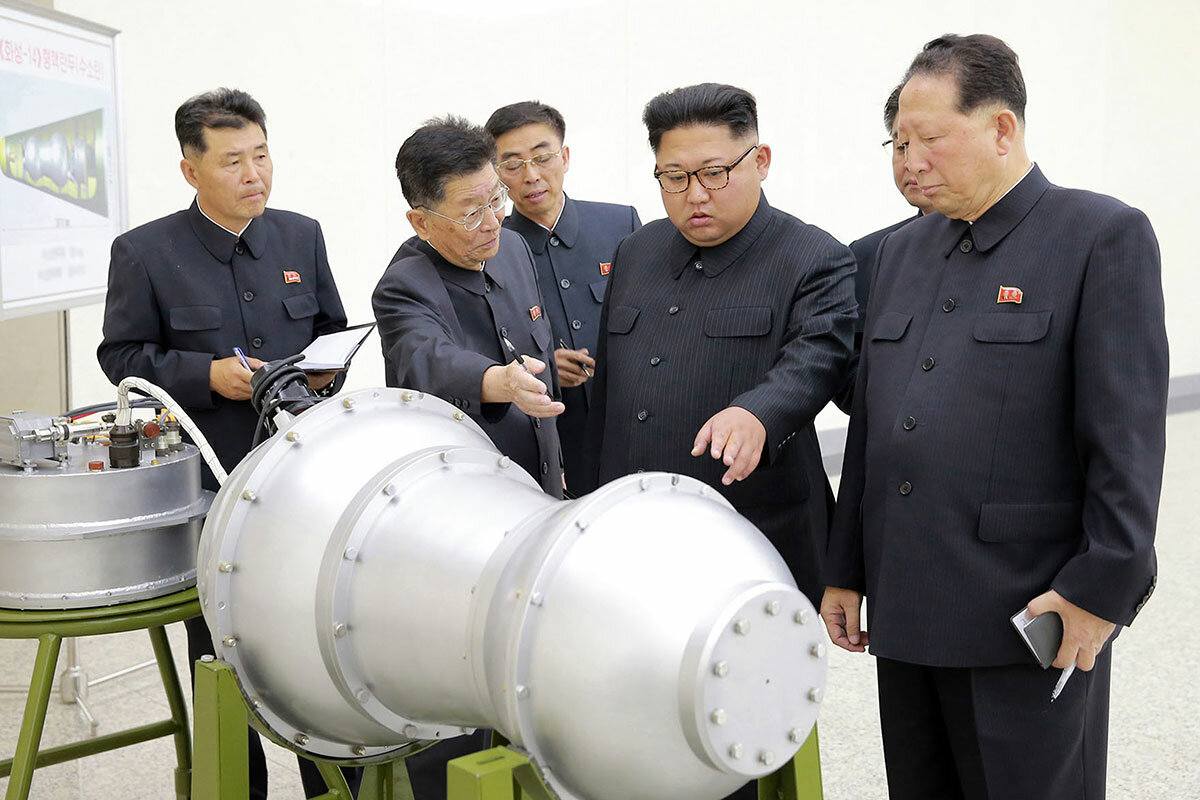As Trump takes off for Asia, region watches for a post-'Pivot' plan
Loading...
| Washington
President Trump clearly places a high priority on US relations with Asia. His 12-day trip to the region beginning this weekend – the longest by a US president since George H. W. Bush’s 1991 marathon – attests to that.
And it’s a priority the American people share with the president: Surveys consistently show that Americans consider Asia more important than any other region for furthering US security and economic interests.
But much less clear nine months into the Trump presidency is what policies and overarching vision will guide US relations with Asia, home to most of the world’s fastest-growing economies and responsible for more than 40 percent of global economic output.
President Obama had his “Asia pivot,” but Mr. Trump knocked the legs out from under that policy when he withdrew the US from the Trans-Pacific Partnership (TPP), the 12-nation trade deal designed to secure US economic leadership in a region increasingly dominated by China and its hybrid statist-capitalist economic model.
But if TPP and the “pivot” are out, leaders at every one of the stops Trump will make – Tokyo, Seoul, Beijing, Da Nang and Hanoi in Vietnam, and Manila, with regional summits adding more leaders to the mix – will want to know what is “in.”
With no clear policies as guideposts, leaders will be watching the unconventional American president for clues on key questions: What does “America First” mean for relations, particularly economic, with Asia? What will Trump’s preference for bilateral relations mean for America’s traditional leadership role in multilateral arenas? Will a Trump focus on North Korea suck the air out of every other issue of interest with the US?
And underpinning them all: Is American leadership waxing or waning in Asia?
“I think the region is just very confused… [it] wants the United States engaged in Asia-Pacific affairs generally, but they don’t want us there only as a military power,” says Matthew Goodman, senior adviser for Asian economics at the Center for Strategic and International Studies (CSIS) in Washington and a former National Security Council director for international economics.
“They want us there engaged in all forms of affairs,” he adds, “and they want us to have some sort of vision.”
'America First' in Asia
Under Trump the US has been more forceful on security issues – countering China by sending out more freedom-of–navigation operations in the disputed South China Sea, for example, and above all jettisoning the Obama administration’s “strategic patience” approach to North Korea in favor of more saber-rattling and diplomatic pressure.
But what the US under Trump hasn’t offered is an encompassing regional policy. It’s almost the inverse of the Obama approach to Asia, some regional experts say.
“The Obama administration packaged its Asia policy in a manner that was compelling and spoke to the region with the ‘pivot,’ but then in many respects they didn’t follow through,” says Michael Auslin, a fellow in contemporary Asia at Stanford University’s Hoover Institution in Washington.
“This administration is being more assertive in demonstrating a strong security role in the region, but what the Trump people have to do is clearly articulate all the facets of US Asia policy under this president,” he adds. “They need to use this trip to allay the fears out there that this administration is backing out of Asia.”
Obama’s Asia “pivot” or “rebalancing” of US assets and interests from the Middle East to Asia stood on three pillars – enhanced security relations, deepened economic and trade ties, and closer engagement with Southeast Asia. Of those three, only the security pillar has been fully retained under Trump, experts say.
“The [economic] pillar … is gone with the withdrawal from TPP,” says Amy Searight, director of CSIS’s Southeast Asia Program. “I don’t see any economic leadership emanating from this administration.”
Trump has spoken of replacing TPP with a series of bilateral trade deals with Asian countries, and has won a renegotiation of the US-South Korea free trade deal after threatening to withdraw from it. But that approach has rattled a region that has prospered under security and economic multilateral frameworks – frameworks the US moved to strengthen and expand over the last decade in particular.
“A bilaterally focused, transactional, America-first economic policy is completely antithetical to what the Obama administration was trying to do, and what the region aspires to in terms of economic engagement,” says Dr. Searight, who recently served as deputy assistant secretary of defense for South and Southeast Asia.
As for Trump administration engagement with Southeast Asia, experts call it mixed. The president has underscored the region’s importance by lavishing attention on its leaders – but sometimes in ways that have left them unsure of the breadth of US policy and where their region fits in it.
After phone calls in April with a number of Association of Southeast Asian Nations (ASEAN) leaders, Trump suggested Secretary of State Rex Tillerson invite ASEAN foreign ministers to Washington – which he did. But then the ministers were treated to a brief meeting focused on North Korea’s threat to the region rather than on clarifying US engagement in Asia.
“You had the foreign ministers fly to Washington for an hour-long meeting with Secretary Tillerson, and 55 minutes of that hour-long meeting were spent on North Korea,” says Brian Eyler, director of the Stimson Center’s Southeast Asia Program in Washington.
“It ended up confirming the doubts about the administration’s bandwidth for the many other issues Southeast Asian leaders are worried about,” he adds, “and it added to the questions about US leadership in the region.”
'Indo-Pacific' policy
Senior officials counter that the administration has already taken numerous steps to underscore Asia’s critical importance to the US, including Trump’s meetings with a number of key leaders – those include Chinese President Xi Jinping and Japanese Prime Minister Shinzo Abe – and Tillerson’s recent Washington speech laying out US priorities for what he called the “Indo-Pacific” region.
Senior administration officials subsequently adopted the “Indo-Pacific” phrasing for press briefings on the president’s trip – raising questions about the signals the White House is trying to send.
For some Washington Asia experts, the use of “Indo-Pacific” is simply a way for Trump officials to differentiate their policy from Obama’s “Asia-Pacific” vision. Others say it signals Trump’s intention to raise India’s prominence in US Asia policy, an idea favored by US ally Japan, suggesting an effort to counterbalance an increasingly aggressive China with the region’s democratic and market-oriented heavyweights.
Michael Green, a former senior Asia official in the George W. Bush White House now at CSIS, says he hears three strains of Asia policy coming out of the administration: Tillerson’s “Indo-Pacific” view, emphasizing working with allies and building an open and transparent economy to counter what Tillerson has called China’s “predatory” economics; another he describes as the “dark sovereignty, America-first transactional ‘We only win when others lose’ perspective”; and the third, which surged briefly after President Xi’s visit with Trump at Mar-a-Lago in April, which is the idea of a “strategic partnership” with China.
Judging by administration officials’ comments, it’s the first option – the more traditional, “deepen relations with allies and partners” option – that appears to have the wind in its sails as Trump embarks on his trip.
But at the same time, the spectacle of “clashing themes within the administration” and Trump’s “unpredictability” will have the region watching every step of the nearly two-week journey for clues to where US Asia policy is headed, Mr. Green says. In particular, all eyes will be on the speech Trump is to deliver at the APEC (Asia-Pacific Economic Cooperation) summit in Da Nang Nov. 10 – a speech a senior administration official says will “present the United Sates vision for a free and open Indo-Pacific region.”
That may sound like the harbinger of a traditional multilateral and highly engaged US Asia policy. But as Green notes, the lingering sense of US “unpredictability” under this president “has the Chinese a bit nervous; it also has friends and allies a bit nervous as well.”








